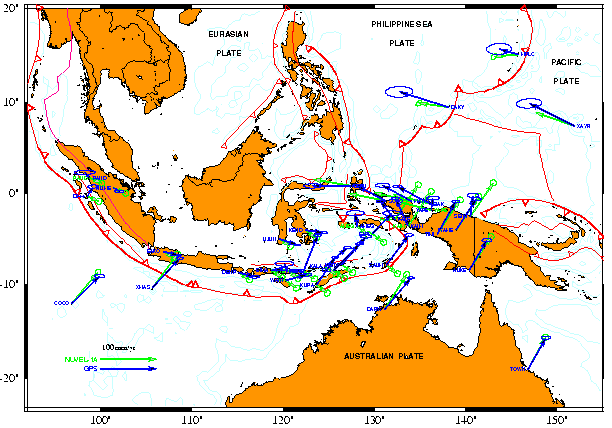Southeast Asia plate kinematics
Y. Bock1, R. McCaffrey2, E. Calais1, J. Genrich1, C. Stevens2, Paul Tregoning3, S.S.O Puntodewo4, C. Subarya4, J. Rais4, and S. Wdowinski5
1Scripps Institution of Oceanography; 2Rensselaer Polytechnic Institute; 3Australian National University; 4BAKOSURTANAL; 5Tel Aviv University
We have performed annual GPS measurements in Indonesia and Australia since 1989,with funding from NSF, NASA and the Indonesian Government. A velocity field derived from these measurements in the ITRF93N reference frame is shown in the Figure. We outline several important results (anticlockwise from west to east in figure): (1) We identify decoupling of oblique convergence of the Indian-Australian Plate and the Java trench near Sumatra. The trench-parallel component is taken up by strike-slip faulting on the Sumatra and Mentawai faults. (2) Convergence of Australian oceanic lithosphere at the Java trench is perpendicular to the trench direction, and agrees with predicted NUVEL-1A motion for Australia/Eurasia. (3) A left-lateral shear zone perpendicular to the arc makes the transition from frontal subduction to collision of the Banda arc with the Australian margin. (4) The Australian continent has accreted the Banda Arc to its margin. Displacement has been transferred into back-arc deformation, along the Wetar and Flores thrusts and within the Banda Sea. (5) Oblique collision between the Pacific and Australian plates in Irian Jaya is accommodated by lateral extrusion of crustal strips (the Bird's Head) to the west towards the east Banda Arc subduction zone. (6) We identify a Sunda Shelf block whose motion agrees with NNR NUVEL-1A motion of the Eurasian plate within 3 mm/yr.

Southeast Asia - 1989.1994 ITRF93N Reference Frame - 95% confidence ellipses
